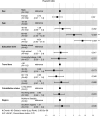The impact of socioeconomic status on glioma survival: a retrospective analysis
- PMID: 39827416
- PMCID: PMC12098201
- DOI: 10.1007/s10552-025-01960-1
The impact of socioeconomic status on glioma survival: a retrospective analysis
Abstract
Purpose: Although sociodemographic factors such as socioeconomic status (SES), travel time to health care, cohabitation status, and region of residence are observed to influence incidence and survival for several types of cancers, it is unclear whether similar effects have been observed in patients with glioma. This study investigates whether these factors affect survival for glioma patients.
Methods: In this retrospective study, the Swedish National Quality Registry for Brain Tumors was used to identify 1,276 patients with glioma WHO grade I-IV for whom data were deposited between 2009 and 2013. The RISK North database, which links data from the National Cancer Quality Register with citizen demographic data from the Longitudinal Integration Database for Health Insurance and Labor Market Studies (LISA), the Total Population Registry (TPR), and the Geography Database (GD), was utilized to assess survival in patients with glioma in relation to education level, cohabitation status, travel time to regional hospitals, and region of residence.
Results: In the multivariable analysis, longer survival was observed among WHO grade III-IV glioma patients with higher education level (middle school (ref) HR: 1, high school HR: 0.81 CI [0.67-0.98], p = 0.033; university/college HR: 0.81 CI [0.66-1.00], p = 0.048). Survival was not associated with travel time, cohabitation status, or region of residence in the multivariable survival analysis.
Conclusion: Low education level was associated with reduced survival for patients with glioma WHO grade III and IV in multivariable survival analyses, but no differences in survival were found in relation to travel time, cohabitation status, or region of residence.
Keywords: Cohabitation status; Education level; Glioma; Region of residence; Socioeconomic status; Survival; Travel time.
© 2025. The Author(s).
Conflict of interest statement
Declarations. Competing interests: The authors declare no competing interests. Ethical approval: The Regional Board of Ethics in Umeå approved the creation of the RISK North database and the overall aim of the study (2014/278-31). Delivery and linking of data were approved by the steering committees and authorities for each included registry.
Figures
References
-
- Louis DN, Perry A, Wesseling P, Brat DJ, Cree IA, Figarella-Branger D, Hawkins C, Ng HK, Pfister SM, Reifenberger G, Soffietti R, von Deimling A, Ellison DW (2021) The 2021 WHO classification of tumors of the central nervous system: a summary. Neuro Oncol 23:1231–1251. 10.1093/neuonc/noab106 - PMC - PubMed
-
- Khanolkar AR, Ljung R, Talback M, Brooke HL, Carlsson S, Mathiesen T, Feychting M (2016) Socioeconomic position and the risk of brain tumour: a Swedish national population-based cohort study. J Epidemiol Community Health 70:1222–1228. 10.1136/jech-2015-207002 - PubMed
-
- Dalton SO, Schuz J, Engholm G, Johansen C, Kjaer SK, Steding-Jessen M, Storm HH, Olsen JH (2008) Social inequality in incidence of and survival from cancer in a population-based study in Denmark, 1994–2003: summary of findings. Eur J Cancer 44:2074–2085. 10.1016/j.ejca.2008.06.018 - PubMed
MeSH terms
Grants and funding
LinkOut - more resources
Full Text Sources
Medical



